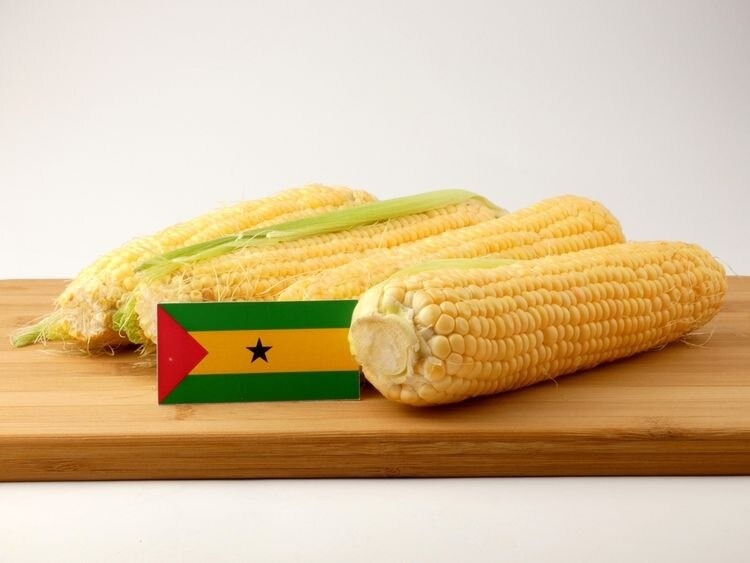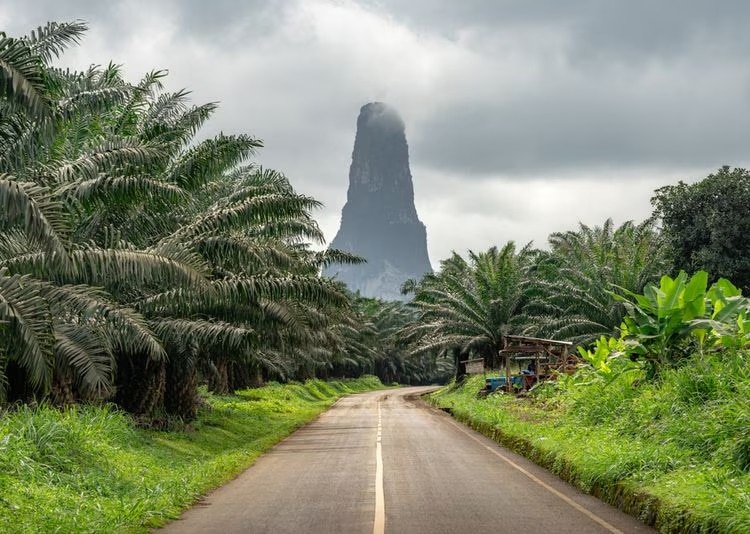Sao Tome and Principe Travel Tips and Information
Official Name
Democratic Republic of São Tomé and Príncipe
Capital
São Tomé
Population
Country Code
Approximately 230,000
ST
Country Code (international calls)
+239
The flight time to Sao Tome and Principe is approximately ---- hours. Check the climate, currency, religion, manners, other information of Sao Tome and Principe below. Wishing you pleasant travels to Sao Tome and Principe.
São Tomé and Príncipe is located in the Gulf of Guinea, off the western coast of Africa, and consists of small islands including São Tomé Island and Príncipe Island.
Local Climate / Weather
São Tomé and Príncipe boasts a tropical climate with warm, humid weather year-round, making it an attractive destination for those seeking a mix of beach relaxation and rainforest exploration. The islands experience two main seasons: the rainy season, from October to May, and the dry season, locally known as the "Gravana," which spans from June to September. During the rainy season, showers can be intense but usually brief, allowing for intervals of sunshine throughout the day. This season offers lush landscapes and vibrant wildlife, making it ideal for eco-tourists and nature photographers. The dry season, with cooler and more stable weather, is the preferred time for beachgoers, hikers, and divers, as the seas are calmer, and the skies are clearer. For travelers seeking seasonal advice, the dry season is recommended, especially for those planning to hike through the islands' national parks, visit beaches, or engage in water sports. Travelers during the rainy season can expect fewer crowds, lower prices, and a unique view of the islands' flourishing flora, though they should be prepared for occasional disruptions in outdoor activities due to weather. São Tomé and Príncipe’s position close to the equator keeps temperatures fairly consistent throughout the year, typically ranging from 23 to 30 degrees Celsius (73 to 86 degrees Fahrenheit), providing a reliably warm and inviting atmosphere. In terms of local culture, São Tomé and Príncipe hosts several colorful events and festivals that showcase the islands' rich heritage. The “Festa de São Tomé” in July celebrates the island’s history with parades, traditional music, and dance, and is one of the most significant cultural events. Meanwhile, the Independence Day celebrations on July 12 mark the country’s liberation with festivities that include local food, music, and dances. Travelers interested in cultural experiences might consider planning around these festivals to gain a deeper appreciation of the local traditions and vibrant community spirit.
Currency & Tipping
Currency
Currency exchange is relatively straightforward in São Tomé, with banks and some hotels offering exchange services. Euros are often accepted by larger hotels and some businesses, making it a convenient option for travelers. It’s advisable to carry cash, as credit card acceptance may be limited, especially outside urban areas.
Tipping
Tipping in São Tomé and Príncipe is generally not mandatory, but it is appreciated as a gesture of goodwill. For services such as dining or guided tours, rounding up the bill or leaving a small tip is common if service has been particularly good. Many locals rely on tourism as a primary income source, so any tips are often gratefully received.
Useful Travel Information

Voltage & Electrical Outlets
In São Tomé and Príncipe, the voltage is 220V with European-style two-pin outlets (Type C and F). Travelers will likely need an adapter for their electronics to ensure compatibility with local sockets, especially for charging devices like phones and cameras.

Internet Connectivity
The internet environment is somewhat limited, with Wi-Fi available primarily in hotels, restaurants, and certain public areas in the larger towns. While some high-end accommodations may offer faster speeds, connections across the islands can be slower than what travelers might be accustomed to. Access outside main areas may be limited, so it’s a good idea to plan around connectivity needs.
Water for Consumption (Drinking Water)
For drinking water, it is recommended to rely on bottled or filtered water, as tap water may not be safe for travelers unfamiliar with local water sources. Bottled water is readily available in hotels, restaurants, and shops across the islands, and it’s a good idea to stay hydrated, especially in the warm tropical climate.
Culture, Religion & Social Etiquette
Culture
São Tomé and Príncipe offers a fascinating blend of African and Portuguese cultures that travelers will find both unique and familiar. The islands’ culture reflects their colonial past and the influence of diverse African roots, showcased in vibrant music, dance, and art. Traditional customs are deeply respected, and locals value community and hospitality, making visitors feel welcome and at home.
Religion
Christianity is the predominant religion in São Tomé and Príncipe, with the majority of the population practicing Roman Catholicism due to Portuguese influence. However, there are also Protestant and other Christian communities, and traditional African beliefs are often integrated with religious practices. This shared Christian heritage may resonate with travelers, creating a sense of cultural connection.
Social Etiquette
São Toméans are generally friendly, warm, and polite, appreciating respect and courtesy from visitors. Handshakes are common greetings, and it’s polite to greet people formally when entering shops or engaging with locals. Travelers may feel comfortable with the emphasis on hospitality, but it’s still wise to observe local customs and ask before taking photos, especially in rural areas where privacy is respected.
Food Culture
São Tomé and Príncipe’s food culture is a delightful fusion of African, Portuguese, and tropical island influences that promises a flavorful experience for travelers. Known for its use of fresh seafood, tropical fruits, and locally grown spices, the cuisine often features dishes like “calulu,” a fish or chicken stew rich with vegetables and spices, and “arroz doce,” a sweet rice pudding dessert. Street food is an affordable and tasty way to sample local flavors, with fried fish, grilled plantains, and cassava being popular options for a quick bite. For an authentic dining experience, travelers can try recommended local restaurants such as “Papa Figo,” which serves traditional dishes with a modern twist, or “Roça São João,” located on a picturesque plantation offering locally sourced, farm-to-table meals. Whether indulging in street food or dining at these popular spots, travelers can immerse themselves in the islands’ unique flavors and culinary traditions.
Major Tourist Attractions & UNESCO World Heritage Sites
Major Tourist Attractions
São Tomé and Príncipe is home to stunning tourist destinations that showcase the natural beauty and cultural richness of these tropical islands. Popular sites include the breathtaking Pico Cão Grande, a volcanic needle that rises dramatically from the jungle, and Praia Banana, a serene, palm-fringed beach perfect for relaxation and snorkeling. Nature enthusiasts can explore Obo National Park, a lush rainforest offering guided hikes, birdwatching, and wildlife spotting. Additionally, the charming capital, São Tomé City, is full of colorful colonial buildings, local markets, and historical sites, where travelers can immerse themselves in the culture and sample local delicacies. Travelers interested in eco-tourism, history, and beach relaxation will find São Tomé and Príncipe’s attractions both diverse and memorable.
UNESCO World Heritage Sites
For history and heritage lovers, São Tomé and Príncipe offer notable UNESCO World Heritage sites that preserve the islands’ unique cultural legacy. Roça Sundy on Príncipe Island, a former cocoa plantation, provides insight into colonial history and even played a role in scientific history, as the site where Sir Arthur Eddington confirmed Einstein's theory of relativity. São Sebastião Museum, located within a 16th-century fortress in São Tomé, also provides a deeper understanding of the islands' past, featuring artifacts and exhibits about local history, colonialism, and independence. Visiting these heritage sites gives travelers a chance to connect with the islands’ past and learn about the significant cultural and scientific contributions of this small island nation.
Travel FAQs
What is the safety situation in Sao Tome and Principe like? What should I be careful of?
It is one of the safest countries in Africa, but there are occasional cases of petty crimes such as pickpocketing and baggage snatching.
What are the main means of transportation in Sao Tome and Principe?
There are no local buses in Sao Tome and Principe, so the only transportation options are airport transfers, taxis, or rental cars.
How much should I tip at restaurants in São Tomé and Príncipe?
Tipping is not a custom.




